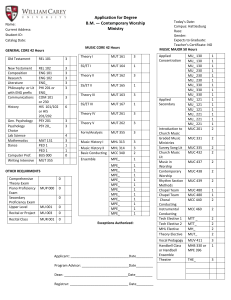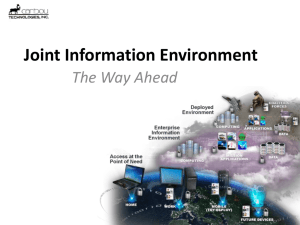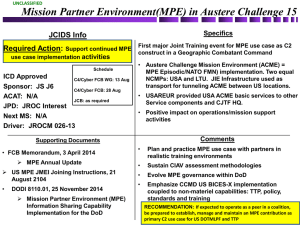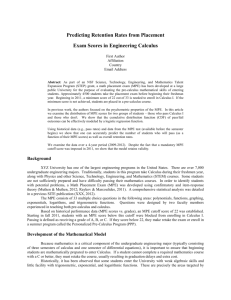TITLE OF BRIEF (U) (32 PT, ARIAL, BOLD ALL CAPS ITALICIZED)
advertisement
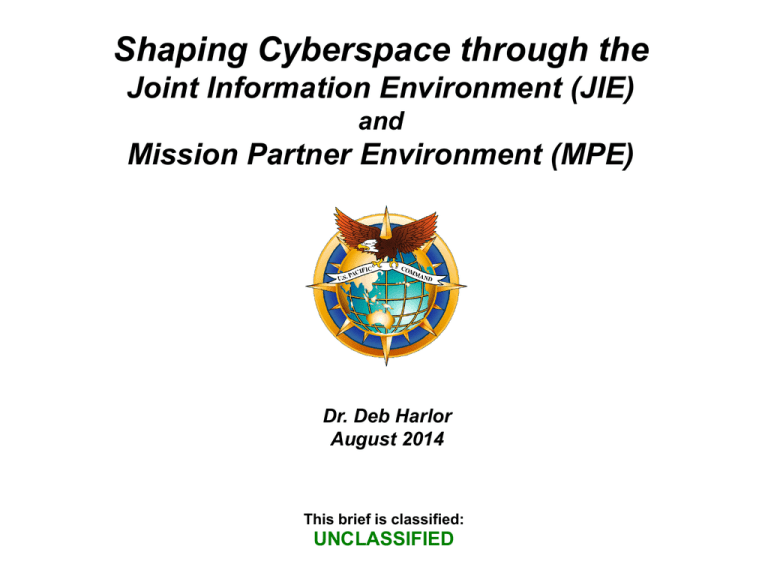
Shaping Cyberspace through the Joint Information Environment (JIE) and Mission Partner Environment (MPE) Dr. Deb Harlor August 2014 This brief is classified: UNCLASSIFIED U.S. National Security Strategy – Creating a Future of Effective Partnerships Strengthening Security Relationships • Our relationships with mission partners are a critical component of our global engagement and support our collective security Modernizing our partnerships/alliances • Worldly interconnectivity Multi-lateral approaches • • • • • Humanitarian Relief Disaster Relief Peacekeeping Nation Building Range of Security Threats Greatest asset is PEOPLE • Champion mutual interests 2 Joint Information Environment (JIE) Coalition Forces Improved Mission Effectiveness • Rapid, dynamic response to support changing mission information needs • Timely, secure access to data and apps needed to accomplish assigned missions • Agile information systems that enable all PACOM missions and any set of partners • Resilient in disconnected, intermittent and lowbandwidth - “DIL” network environments. Deployed Environment Mission Applications Computing Data “Enterprise Information Environment” APEX Navy ERP AT21 iEHR Enterprise Email DCO AFATDS Data Computing Close Combat TM Airman Defense Travel Fundamentals Applications “Enterprise Information Environment” Increased Cyber Security • Operate, monitor and defend IT assets to attain and maintain information dominance • Robust and resilient providing the integrity, availability and confidentiality needed to assure all PACOM missions and any set of partners. Home Work Mobile (TDY/Deploy) ?? Future devices IT Efficiencies and Joint Services • Consistent IT architecture supports effective fielding of capabilities • Interoperable information systems developed and implemented with maximum performance, reliability, and at best value minimum waste. 3 Mission Partner Environment (MPE) MPE Enduring: Strategic level Characteristics • • • • Persistent Specified Mission Partners NGO, NGA, industry Integrated with JIE MPE Episodic: Operations/Tactical level Characteristics • • • • Mission focused Unknown partners JTF/CJTF capabilities Contingencies MPE Enablers: • • • • Joining-Membership-Exit-Instructions (JMEI) Coalition Interoperability Assurance & Validation Data Classification Exercises with Coalition Partners 4 PACOM’s JIE Vision Internet NIPRNET SIPRNET Mission Partners Joint Information Environment (JIE) & Mission Partner Environment (MPE) combine to create a “single pane of glass” for operators. Core Data Center SIPRNET JIE/MPE “Network Enclaves” Unclassified networks NIPRNET GCCS Common Operation Picture Classified networks CENTRIX-JPN Common Operation Picture Internet Mission Network Access multiple data sources with a single display 5 Common Mission Network Transport (CMNT) • Information content is exposed to less people because of inherent compartmentalization (separate channels) • All traffic is IPSec encrypted – any unencrypted traffic is suspect • NIPRNET traffic is protected at the same level as SIPRNET • Internet traffic is separated from NIPRNET • Takes advantage security features of IPv6 Application Service Points (ASP) in a data center CMNT – Black Core Mission-XYZ Mission-ABCD Mission-1234 SIPRNET NIPRNET Internet GUARD The Internet 6 Commercial Solutions for Classified (CSfC) Benefits of CSfC • Releasable to International Partners • Improved Responsiveness and Flexibility • Easier to obtain • Greater engagement with industry • Based on the latest technologies NSA Guidance • Product Selection • Configuration Guidance • System Testing • Residual Risk Analysis Inner VPN Device Site A Outer VPN Device Outer VPN Device Black Network Inner VPN Device Site B 7 PACOM’s JIE/MPE Approach Summary NNI Situational Awareness and C2 of GIG Common Operational Picture IC UTILITY PRIORITY CAPACITY RISK LEVEL Dynamic Computer Network Defense MPE Transport (MPET) Network performance, security and risk management Nation B (NB) NNI Nation C (NC) NNI Quality of Service IPSec SIPRNET Thin clients that can connect to multiple security domains “Black Core” PNI IPSec IPSec IPSec IPSec CSfC – Commercial Solutions for Classified Mission-AB (Bilat) IPSec “Gray Core” AVE – Agile Virtual Enclaves CMNT – Common Mission Network Transport IPSec – Internet Protocol Security NNI – National network Interface PNI – Partner Network Interface One layer IP-Sec “Grey Core” Two layer IP-Sec “Black Core” CMNT IPSec PNI Mission-NBNC (Multilat) AVE Cross Domain Controlled Interface New Unanticipated Episodic Mission Partner 8 JIE and MPE Approach & Benefits Improved Mission Effectiveness / Operational Flexibility Responsive, Agile • One network – dynamic enclaves • Reuse of the network with common equipment • Add new network enclaves rapidly Improved information sharing • More enclaves can be employed • Accommodates trust management for discretionary disclosure of sensitive information Increased Cyber Security Defensible, Protected, Proactive • Compartmentalized / Virtualized • Monitored / Controlled / Concealed IT Efficiencies / Joint Information Services Economical, Interoperable • One network – common equipment • Served clients; not dedicated client-server o Less to maintain / easier to monitor 9 Questions? This brief is classified: UNCLASSIFIED

